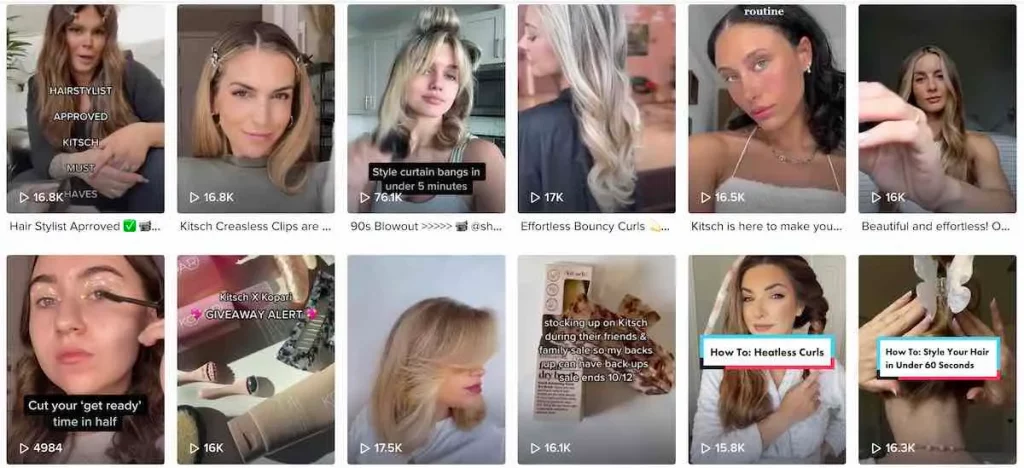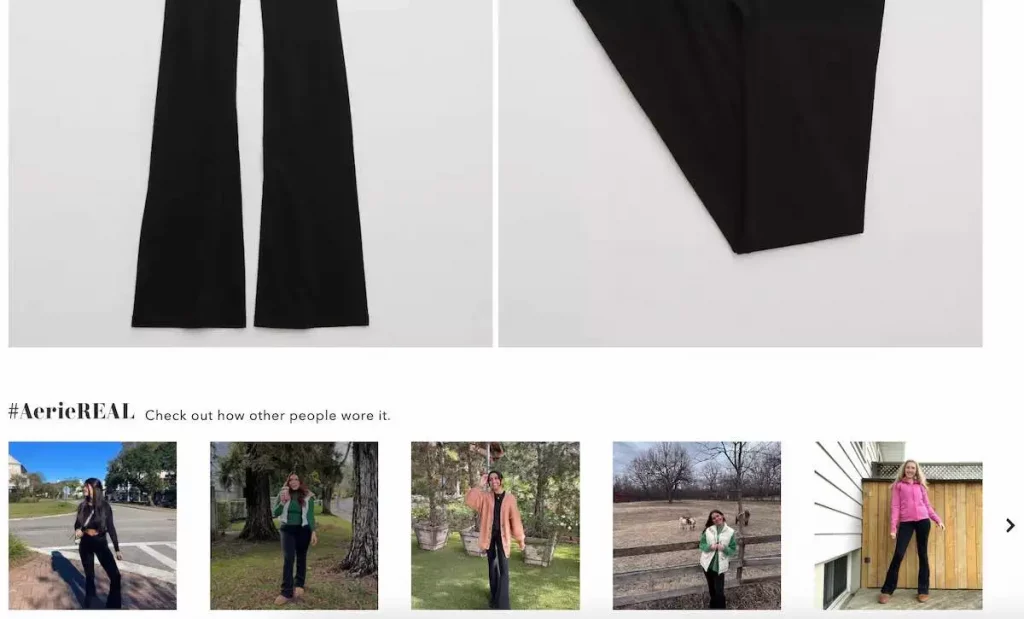The Untapped Potential of User-Generated Content

With the rise of social media, everyday people now have platforms to create and share their own stories. How people consume content and interact with brands has changed. More brands are looking at user-generated content (UGC) to create more effective marketing. UGC amplifies brand stories, creates an authentic connection with audiences, and drives engagement.
Not only is UGC effective for connecting brands to consumers, but it’s also becoming easier to create. From interactive polls and quizzes to user-generated videos, there are various ways to produce engaging content and get people involved.
When done right, UGC can be a powerful tool for brands to build an emotional connection with their customers. Let's explore the untapped potential of UGC and how brands can leverage it to reach their target audience.
Table of contents
- Why Is User-Generated Content Important?
- User-Generated Content Statistics
- How to Get User-Generated Content
- User-Generated Content Examples
- How Top Brands Do User-Generated Content Marketing
- Should You Hire an Agency to Manage Your UGC?
Why Is User-Generated Content Important?
Picture this: A Fortune 500 beauty brand launches a new product.
To build a campaign that resonates with its target market, the brand's marketing team decides to partner with UGC creators to produce content that exemplifies the messaging for the launch campaign.
The brand strategically selects UGC creators from various backgrounds, allowing the content to reflect unique perspectives. The creators produce the content, and the brand uses it in both organic and paid channels. The brand floods its website and social media channels with beautifully curated, human-generated content, and the results are profound.
The campaign achieves its goal: consumers feel a deeper connection with the brand, resulting in more engagement and sales.
In a nutshell, this is why user-generated content is so important. It amplifies brand stories, creates an emotional connection with consumers, and drives engagement.
UGC allows brands to humanize their message and share it with target audiences in an authentic way. Let's take a closer look at the most prominent reasons why brands need UGC:
Builds trust
People trust people, not companies. According to the 2021 State of UGC report by Tintup, 93% of marketers agree that consumers trust user-generated content more than content brands create.
User-generated content builds trust with consumers because it provides valuable insight into the experiences of real people who have used the product or service. Traditional marketing methods simply can’t create the same level of trust.
User-generated content bridges the gap between the brand's messaging and the customer experience. It creates an authentic, emotional connection with the target market.
Serves as social proof
Social proof is the phenomenon where people mimic the behaviors of others. In other words, when people see others have a positive experience with a brand, they are more likely to purchase from that brand.
User-generated content is social proof. UGC verifies a brand's legitimacy and influences consumer behavior.
Usually free
One of the benefits of digital media is that it’s relatively inexpensive to produce content. User-generated content is no exception—it is usually free or significantly more affordable than traditional marketing strategies.
If you work with influencers, you might spend a bit more. However, UGC often happens naturally without any extra cost. Even better, user-generated content comes from people who already use (and love) your product or service.
The beauty of social media is that it offers everyone a platform to post about the brands they love. Through UGC, your existing customers promote your products and services to their existing networks, which can skyrocket your conversions.
Saves on content creation costs
You might want to think twice about spending $5,000 on a professional video for your next campaign. Why? Because user-generated content can provide you with the same level of quality and engagement for a fraction of the cost.
Check out this sustainable gift guide example. The creator talks about his favorite sustainable brands to shop from during the holiday season. As users scroll through their TikTok feeds, they will be more likely to pay attention to this video over a branded video because it’s content created by a real person, not a brand.
User-Generated Content Statistics
If you're interested in learning about the latest UGC insights, check out these recent statistics:
- UGC ads receive 20-50% more attention than branded ads (Consumer Acquisition)
- 78% of consumers can tell when a brand is promoting a product or service in an ad (TINT's 2022 State of User-Generated Content Report)
- UGC content receives 12x more engagement than any other content type (Consumer Acquisition)
- 79% of people claim that UGC has a major influence on their buying decisions (Nosto)
- Companies that used UGC on their websites reported an 18% increase in revenue (Annex Cloud's The New Wave of User Generated Content Report)
- 85% of people say that UGC influences them more than branded content (Adweek)
- Consumers are 2.4x more likely to view UGC as more authentic than branded content (Hootsuite)
How to Get User-Generated Content
So, you're ready to make UGC a part of your content strategy. But where do you start?
There are many ways to collect user-generated content for your brand. Your chosen method will depend on your objectives, resources, and target audience. You can reach out to influencers, run a hashtag campaign, ask customers for reviews and feedback, or run contests and giveaways.
Additionally, you can encourage customers to share their experiences or stories with your brand through social media posts and videos. Collecting authentic feedback from real people will build trust with potential customers and show them why they should choose your products or services.
Here's a closer look at some surefire methods for soliciting user-generated content:
Establish Social Listening and Monitoring
Social listening is the process of monitoring conversations taking place on social media. This includes keeping track of conversations related to topics and keywords that are relevant to your business, as well as tracking mentions of your brand.
The goal of social listening is to gain valuable insights into customer preferences, trends in the industry, and even competitor activities. By using social listening, you can create more effective strategies for engaging with customers and creating content that resonates with them.
What does this have to do with UGC? You can easily find user-generated content that your customers have created by developing a process to track and monitor mentions of your brand online. This is a great way to leverage authentic stories from real people who already love and use your products.
Social listening platforms track keywords and hashtags related to your brand, so you can find content even if the user didn't mention or tag your brand. It also captures online conversations related to your industry and competitors.
These insights will give you a better understanding of your target audience's needs, interests, and preferences.
Here are a few ways to get started with social listening:
- Set up social mention notifications in Hootsuite
- Turn on Google Alerts
- Create a branded hashtag and encourage your followers to use it
Always Ask For Permission to Use Content
Asking for permission to use someone’s user-generated content is an essential step in protecting both the creator's rights and your brand's reputation.
It shows respect for the person who created the content and ensures they are comfortable with how their work is used.
Additionally, it can help protect you from potential legal issues, such as copyright infringement. When using UGC in your marketing campaigns, it’s always best to get explicit consent from the people who created it.
Example Template For Requesting Permission to Use UGC
Dear [Name],
I am [name] from [organization], and I love the post you created featuring our [product/service]!
I would like to request your permission to use this content in our promotional materials and website. In exchange, we will be happy to include a link back to the original source of your work as well as provide appropriate credit for your creation.
Please let me know if you are willing to grant me permission by replying to this email with your written consent. I look forward to hearing from you!
Kind Regards,
[Your name]
Make It All About Your Customers
Social media is inherently "me-focused." People are more likely to engage with and share content that is tailored to their individual needs and interests.
Therefore, brands can gain an edge over their competitors by making their products and services about the end user.
A recent example is the viral Lensa AI app. Users upload 10-20 photos of themselves and get an AI-generated set of illustrations that look like they were created by a digital artist. It blew up in December 2022 because of user-generated content. People signed up for the paid app and shared the AI images of themselves on social media.
As a result, the UGC led to real subscriber growth and revenue gains. The app made $8 million in revenue in December. Its annual revenue was around $16 million, so close to half of its revenue for the year came from user-generated content.
Engage With Your Audience on Social Media
Social media is a powerful way to engage with your audience and build relationships. Respond to comments, questions, and messages promptly. Showing that you care about your audience’s feedback and concerns will encourage them to interact with your brand.
Liquid Death has a phenomenal Twitter presence because the brand frequently replies to comments and retweets its followers' content. Instead of making every single post about its products, the brand inserts witty remarks and jokes into the conversation to make it more interesting and engaging.
Send Sample Products
Sending sample products to influencers and UGC creators can be a great way to build relationships with niche audiences while fostering user-generated content. Influencers can create content featuring your product, which can then be shared on their social media channels. This helps spread brand awareness and reach more potential customers.
Additionally, sending sample products to UGC creators may result in them creating more high-quality content around your product or service. This can help drive engagement with the brand and increase follower counts.
Leverage Information on Review Sites
It's crucial to stay up-to-date with what customers are saying about your product or service. Keep tabs on review sites such as TripAdvisor, Yelp, and Google Reviews.
These sites provide valuable insights into customer experiences and can be used to improve customer loyalty. They also serve as a source of user-generated content that can be used in marketing campaigns. For example, you can leverage positive customer reviews to create an effective testimonial video for your website or social media channels.
User-Generated Content Examples
There is no one-size-fits-all approach when it comes to leveraging user-generated content. Your strategy will depend on your marketing objectives and the type of content you want to create.
Here are a few examples of top-tier UGC to inspire you:
1. Coca-Cola: The "Share a Coke" Campaign
The "Share a Coke" campaign let customers personalize their beverages with their name. The UGC from this campaign is always creative and often goes viral, making it one of the most successful user-generated content campaigns in history.
2. Spotify Wrapped
Spotify Wrapped lets users review their music streaming habits from the past year. This campaign has resulted in some of the most creative user-generated content on social media, as users usually share screenshots of their listening stats with friends and family.
The Spotify Wrapped campaign allows each user to put a spotlight on their favorite music and share it with others. It taps into the "all about me" principle, making people feel unique and valued.
3. Ocean Spray
Nathan Apodaca's viral Ocean Spray TikTok video is a perfect example of how UGC content can go viral. What started as a simple video of Apodaca skateboarding while drinking cranberry juice has become a worldwide phenomenon.
The success of this UGC prompted Ocean Spray to respond with their own user-generated content, helping them reach even more potential customers. In fact, Ocean Spray gifted Apodaca a brand-new truck for his efforts! (If that doesn't show the power of TikTok, we don't know what does.)
4. Kitsch
TikTok has recently seen the rise of a new trend: heatless curls. The trend is all over the app and is being created using Kitsch’s Heatless Curling Set. This product offers an easy, no-heat way to get wavy, beachy hair in mere minutes.

Those who have tried the technique are sharing their results on TikTok and praising the time saved from not having to use hot tools. Videos featuring this hack often include hashtags like #heatlesstiktok or #kitschheatlesscurls, allowing other users to easily navigate these videos to see how it’s done.
The trend has gained popularity because of its convenience, and many people are using their creativity to create their own unique looks with it. It's become an excellent way for TikTokers to showcase their hairstyling skills without having to put in too much effort or wait for long periods for their curls to set.
How Top Brands Do User-Generated Content Marketing
Small businesses and brands with big marketing budgets are trying to crack the UGC code. Let's take a closer look at what the top brands in the world do to leverage UGC in their marketing strategies.
Make a List of Potential UGC Creators
The first step in developing a user-generated content strategy is to create a list of potential UGC creators. The list should include influencers, bloggers, and social media users who have the potential to produce high-quality content that resonates with your target audience.
We recommend starting by pulling data from your CRM, reviewing social mentions, and conducting micro-influencer research to find the most cost-effective partnerships.
Create a Detailed Brief for UGC Creators
Thorough briefs save everyone time. The more detailed your brief is, the better UGC creators will be able to produce content that meets your objectives and resonates with your target audience.
A UGC brief should include the following:
- A clear overview of the campaign objectives, including the desired outcome and timeline
- Specific guidelines for content creation, such as hashtags or style guides to be followed by contributors
- Creative ideas to inspire users to create engaging content
- Rights and permissions agreements with contributors
- Evaluation criteria for assessing user-generated content submissions
- Reimbursement structure for user-generated content creators
Feature UGC on Product Pages
Showcasing user-generated content (UGC) on product pages boosts customer engagement and builds trust with potential buyers. For example, #AerieReal is Aerie’s UGC-led campaign. The retailer features real people wearing its products on each product page.

Here are some tips on how you can feature UGC on product pages:
- Include customer reviews or testimonials along with product descriptions.
- Feature relevant social media posts or photos of customers using the products.
- Incentivize users to share their thoughts, stories, and pictures through contests or giveaways.
- Highlight positive customer feedback in the form of ratings, rankings, comments, and reactions collected from different platforms.
- Encourage customers to create stories about their experiences with your products.
Use UGC Videos in Digital Ads
Once you amp up your ads with UGC, your conversions will never look the same. You'll be able to create engaging ads that feature real people who have already tried your products and had a remarkable experience. Below are some of the benefits of using UGC in digital ads.
It doesn’t feel like an ad
User-generated content is naturally authentic. When a real customer vouches for your business, people are more likely to listen and consider it. Because it is a person talking about your product or service, it doesn’t feel like an ad.
Added credibility
Seeing real people interacting with your product or service adds credibility to your business. It can help build trust in your brand and make it more appealing for others to purchase from you.
Cost savings
Using UGC videos is also cost-effective, as you don’t need to invest in expensive video production costs. You can also reuse existing UGC videos multiple times and on different platforms, allowing you to get more bang for your buck.
Humanization
By giving customers a platform to interact with your brand, you can create a feeling of personalization and connection. This helps cultivate loyalty in your customer base and build lasting relationships that will benefit your business over time.
Track and Measure the Results From UGC
Finally, tracking and measuring the results of your user-generated content campaigns is crucial. Tracking the success of UGC is essential to optimize future strategies and ensure that you're getting the most out of your efforts.
Analytics tools like Google Analytics can help you see how much traffic your UGC is driving and how your customers are engaging with it. It's also a good idea to set up surveys or customer feedback forms to get more in-depth insights into the effectiveness of your UGC campaigns.
Should You Hire an Agency to Manage Your UGC?
At Goodway, our specialized team of professionals can help you identify user-generated content that is aligned with your brand values. We'll ensure that any videos posted are up to date, on-brand, and provide maximum engagement.
Contact us to learn more about how we can help you take advantage of the untapped potential of user-generated content. By partnering with us, you'll be able to maximize your return on investment and get the best results from your campaigns.





